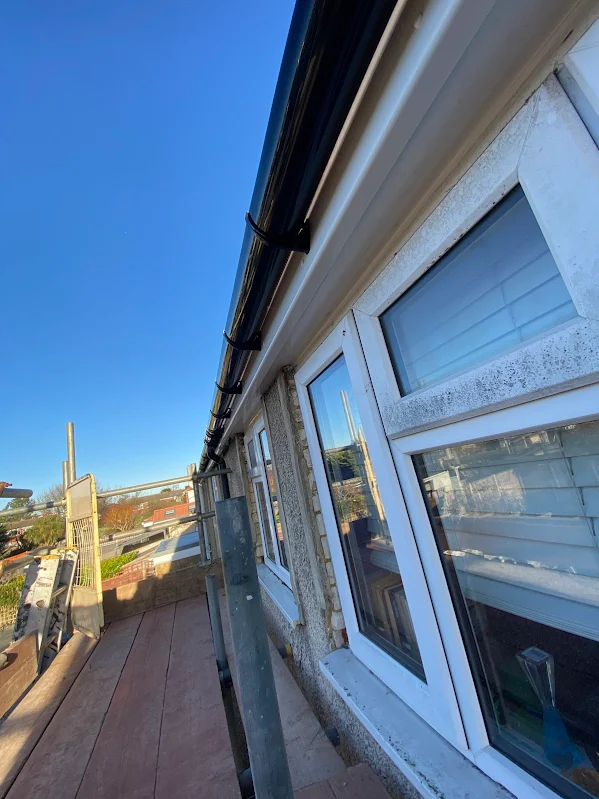+44 7853 968135
What are soffits and fascia?
Every British homeowner encounters these essential roofing components during property maintenance, yet many remain uncertain about their critical role in protecting structural integrity and enhancing kerb appeal. Soffits and fascia boards create the vital transition between your roof structure and exterior walls, delivering both weatherproofing protection and aesthetic finishing that significantly impacts property values across the UK.
These roofing elements work together as an integrated system, safeguarding your home from moisture penetration whilst providing the polished appearance that defines quality construction. Understanding their function, materials, and maintenance requirements enables informed decisions when planning improvements or addressing deterioration issues that commonly affect older properties.
Understanding Fascia Board Functions and Installation Requirements
Fascia boards serve as the vertical finishing elements that run horizontally along roof edges, directly attached to rafter ends to create the structural foundation for your guttering system. These boards provide the mounting surface for essential drainage components whilst delivering the clean, straight lines that define your roofline’s professional appearance.
Modern fascia installation requires precise measurement and expert fitting to ensure proper water management and structural support. Professional contractors typically specify boards measuring 150mm to 250mm in depth, depending on your roof’s architectural design and existing rafter dimensions.
The positioning of fascia boards creates the visible face that homeowners see when viewing their property from street level. Quality installation prevents common issues including water penetration behind guttering, pest entry points, and the unsightly sagging that occurs when inadequate support compromises the system’s integrity.
Need some Support with your Fascia and Soffits? Speak with a member of our Professional Fascia and Soffits Team here

Comprehensive Soffit Types and Ventilation Solutions
Soffits span the horizontal area beneath roof overhangs, creating the ceiling effect between fascia boards and exterior walls. These panels serve dual purposes, providing weather protection whilst facilitating essential roof space ventilation that prevents condensation buildup and maintains structural health.
Ventilated soffits incorporate strategically positioned slots or circular vents that allow controlled airflow into roof spaces without permitting pest entry. This ventilation proves particularly crucial in modern homes with improved insulation, where reduced natural airflow can create moisture problems leading to timber rot and energy efficiency losses.
Solid soffits offer alternative solutions for properties requiring different aesthetic approaches or specific architectural compatibility. These smooth panels deliver clean lines preferred in contemporary designs whilst still providing weather protection, though additional ventilation solutions may be necessary elsewhere in the roof structure.
Material Selection Guide for Long-Term Performance
Choosing appropriate materials for soffits and fascia requires careful consideration of durability, maintenance requirements, and aesthetic preferences that align with your property’s architectural style. uPVC dominates the British market due to exceptional weather resistance and minimal ongoing maintenance needs, making it particularly suitable for coastal locations where salt exposure accelerates material degradation.
Timber options appeal to conservation areas and period properties where planning regulations may require natural materials that complement historical features. Modern timber treatments significantly extend service life, but regular maintenance including painting or staining remains essential to prevent rot and weather damage that commonly affects untreated wood.
| Material Type | Expected Lifespan | Annual Maintenance | Cost per Linear Metre | Primary Advantages |
|---|---|---|---|---|
| uPVC | 25-30 years | Minimal cleaning | £12-18 | Weather resistant, cost-effective |
| Treated Timber | 20-25 years | Annual treatment | £15-28 | Traditional appearance, repairable |
| Aluminium | 35-40 years | Occasional cleaning | £20-35 | Lightweight, corrosion resistant |
| Composite | 30-35 years | Bi-annual inspection | £25-45 | Wood appearance, enhanced durability |
Premium materials including aluminium and composite options justify higher initial investments through superior longevity and reduced maintenance requirements. These materials prove particularly valuable for properties facing extreme weather conditions or where access difficulties make frequent maintenance impractical.
Soffit and Fascia Material Options and Performance
Understanding material performance helps homeowners make informed decisions based on their priorities and budget constraints. uPVC dominates the UK market due to its excellent weather resistance and minimal maintenance requirements, making it particularly suitable for coastal areas where salt exposure can accelerate material degradation.
Timber options appeal to conservation areas and period properties where planning restrictions may require natural materials. Modern timber treatments significantly extend lifespan, but ongoing maintenance including regular painting or staining remains necessary to prevent rot and weather damage.
For properties requiring enhanced durability or facing extreme weather conditions, aluminium and composite materials offer superior longevity. These premium options justify higher initial costs through extended service life and reduced maintenance requirements over time.
Regional Installation Costs and Timeframes
| Region | Average Cost per Linear Metre | Typical Installation Time | Seasonal Variations |
|---|---|---|---|
| London/South East | £25-£35 | 2-3 days | +15% winter premium |
| Midlands | £20-£30 | 2-3 days | +10% winter premium |
| North England | £18-£28 | 2-4 days | +5% winter premium |
| Scotland/Wales | £16-£25 | 2-4 days | +20% winter premium |
Regional variations reflect local labour costs, material availability, and seasonal demand fluctuations across the UK. Scotland and Wales often experience longer installation times due to weather conditions and reduced contractor availability, particularly during winter months.
Installation timing significantly impacts both cost and quality outcomes. Spring and autumn represent optimal periods for soffit and fascia work, offering stable weather conditions and competitive pricing as contractors balance their seasonal workload.
The UK government’s guidance on home improvements provides essential information about planning requirements and building regulations that may affect your project. Most soffit and fascia replacements fall under permitted development rights, but conservation areas and listed buildings may require additional approvals.
Understanding these regional and seasonal factors enables homeowners to plan effectively and secure the best value for their investment. Early planning allows flexibility in scheduling and contractor selection, potentially achieving significant cost savings whilst ensuring quality workmanship.
Understanding Soffits and Fascia for Your Home
Soffits and fascia represent fundamental components of your home’s roofing system, combining practical protection with aesthetic enhancement. These elements work together to create a weatherproof barrier that safeguards your property’s structural integrity whilst contributing significantly to its overall appearance and value.
The investment in quality soffits and fascia pays dividends through enhanced property value, reduced maintenance costs, and improved energy efficiency. Modern materials and installation techniques offer homeowners unprecedented durability and performance, making replacement projects particularly worthwhile for older properties with deteriorating timber components.
Professional installation ensures optimal performance and longevity, with skilled contractors providing warranties and guarantees that protect your investment. The complexity of proper installation, including ventilation requirements and weatherproofing details, makes DIY approaches inadvisable for most homeowners.
Key considerations for your soffit and fascia project include:
Need Help with Fascia and Soffit Matters? Talk to one of our Fascia and Soffits Experts today!
What Are Soffits and Fascia: Frequently Asked Questions
uPVC represents the most popular choice for British homes due to its excellent weather resistance and minimal maintenance requirements. Timber, aluminium, and composite materials offer alternative options for specific architectural styles or performance requirements.
Quality uPVC soffits and fascia typically last 20-30 years with minimal maintenance, whilst timber options may require replacement every 15-25 years depending on maintenance levels. Regular inspection helps identify deterioration before structural damage occurs.
Most soffit and fascia replacements fall under permitted development rights and don’t require planning permission. However, properties in conservation areas or listed buildings may need approval before commencing work.
Visible rot, peeling paint, pest damage, or water stains on interior walls suggest deterioration requiring professional assessment. Sagging or loose boards pose immediate risks and require urgent attention.
Professional installation is strongly recommended due to height safety risks and technical requirements including ventilation and weatherproofing. Skilled contractors provide warranties and ensure compliance with building regulations.
Ventilated soffits allow essential airflow into roof spaces, preventing condensation buildup and reducing energy costs. According to Wikipedia’s comprehensive guide to soffits, proper ventilation significantly extends roof structure lifespan and improves indoor air quality.
Modern manufacturers offer extensive colour ranges including white, black, anthracite grey, and various wood-effect finishes. Colour coordination with existing architectural features enhances overall property appearance.
Standard installation on a typical three-bedroom house takes 2-3 days, depending on access complexity and weather conditions. Larger properties or those requiring structural repairs may need additional time.
The UK government’s building regulations specify requirements for ventilation and fire safety that affect soffit installation. Professional contractors ensure compliance with all relevant standards.
Reputable manufacturers provide 10-20 year warranties on materials, whilst professional installers typically offer 5-10 year workmanship guarantees. Comprehensive coverage protects your investment and ensures long-term performance.
Consider factors including budget, maintenance preferences, local climate conditions, and architectural style. uPVC offers the best balance of performance and cost for most UK homes.
Professional assessment identifies any structural repairs required, whilst homeowners should ensure clear access and protect landscaping. Scaffolding requirements depend on property height and access complexity.
Properly installed soffits with appropriate ventilation reduce heating costs by preventing ice dams and moisture issues. Modern materials also provide better insulation compared to deteriorating timber components.
uPVC options require only occasional cleaning with mild detergent, whilst timber components need regular painting or staining. Annual inspection identifies potential issues before they become costly problems.

